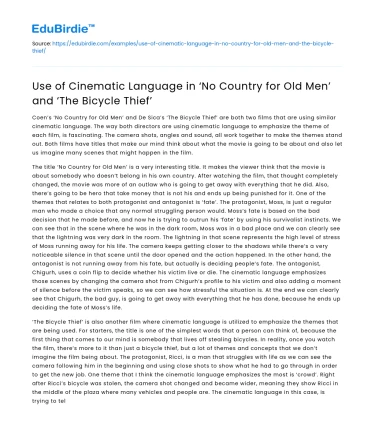Coen’s ‘No Country for Old Men’ and De Sica’s ‘The Bicycle Thief’ are both two films that are using similar cinematic language. The way both directors are using cinematic language to emphasize the theme of each film, is fascinating. The camera shots, angles and sound, all work together to make the themes stand out. Both films have titles that make our mind think about what the movie is going to be about and also let us imagine many scenes that might happen in the film.
The title ‘No Country for Old Men’ is a very interesting title. It makes the viewer think that the movie is about somebody who doesn’t belong in his own country. After watching the film, that thought completely changed, the movie was more of an outlaw who is going to get away with everything that he did. Also, there’s going to be hero that take money that is not his and ends up being punished for it. One of the themes that relates to both protagonist and antagonist is ‘fate’. The protagonist, Moss, is just a regular man who made a choice that any normal struggling person would. Moss’s fate is based on the bad decision that he made before, and now he is trying to outrun his ‘fate’ by using his survivalist instincts. We can see that in the scene where he was in the dark room, Moss was in a bad place and we can clearly see that the lightning was very dark in the room. The lightning in that scene represents the high level of stress of Moss running away for his life. The camera keeps getting closer to the shadows while there’s a very noticeable silence in that scene until the door opened and the action happened. In the other hand, the antagonist is not running away from his fate, but actually is deciding people’s fate. The antagonist, Chigurh, uses a coin flip to decide whether his victim live or die. The cinematic language emphasizes those scenes by changing the camera shot from Chigurh’s profile to his victim and also adding a moment of silence before the victim speaks, so we can see how stressful the situation is. At the end we can clearly see that Chigurh, the bad guy, is going to get away with everything that he has done, because he ends up deciding the fate of Moss’s life.
Save your time!
We can take care of your essay
- Proper editing and formatting
- Free revision, title page, and bibliography
- Flexible prices and money-back guarantee
‘The Bicycle Thief’ is also another film where cinematic language is utilized to emphasize the themes that are being used. For starters, the title is one of the simplest words that a person can think of, because the first thing that comes to our mind is somebody that lives off stealing bicycles. In reality, once you watch the film, there’s more to it than just a bicycle thief, but a lot of themes and concepts that we don’t imagine the film being about. The protagonist, Ricci, is a man that struggles with life as we can see the camera following him in the beginning and using close shots to show what he had to go through in order to get the new job. One theme that I think the cinematic language emphasizes the most is ‘crowd’. Right after Ricci’s bicycle was stolen, the camera shot changed and became wider, meaning they show Ricci in the middle of the plaza where many vehicles and people are. The cinematic language in this case, is trying to tell us that Ricci is now alone and lost in the city, where he will never be able to get his bicycle back. That theme is still expressed before Ricci tries to steal the bicycle, as he was looking around him and there was so many people riding and walking with their bicycles. Then there is a POV shot of Ricci first seeing the bike propped against the wall, then each time he goes back, the back is smaller in the shot until it disappears entirely. Instead, Ricci gets larger in the frame, implying the psychological anguish he is in as he settles on his theft game-plan. Then he sits on the curb next to Bruno. As an important scene was going to start, the camera is slowly zooming in on the couple as the bikes are passing between them, until the frame is on them only. Then comes the scene where he is caught stealing the bicycle. The camera shots are wide enough to show that most people around him are trying to catch him, which shows a lot of ‘crowd’ versus him alone. There is yet another cinematic language, that was used in most of the scenes, that we didn’t talk about, which is the sound. The music gets gradually very dramatic before any action happens.
‘No Country for Old Men’ and ‘The Bicycle Thief’ are two great films that are definitely not the same genre, but are still very similar when using cinematic langue. Using cinematic language in these two films was very effective, because it emphasized the themes that are used. I think that cinematic language helped both directors make the audience feel like they are included in most of the scenes, so they can also feel the tension that the characters are going through.






 Stuck on your essay?
Stuck on your essay?

